A Practical Study of the Decrees of the 20th Century Coinage
by Pablo Luna Herrerabased on his wesite (in Spanish) eldatonumismatico
In order for a coin to circulate, the government’s approval is necessary. This process ends when the coin specifications are published in the official gazette and then the coin production can start at the mint facilities. In Mexico the Diario Oficial de la Federación (Official Journal of the Federation) or DOF is the place where all the decrees that contain the coin weight, diameter, metal, fineness, design, edge, etc. are published. In the official web site of the DOF a definition is granted:
The Official Journal of the Federation is the institution of the Constitutional Government of the United Mexican States, that have the function to publish in the national territory: laws, regulations, orders, agreements, circulars, and others acts issued by the Federal branches, with the purpose that all these acts be observed and enforced correctly in its respective areas of competence.
However, when studying contemporary Mexican Numismatics, the researcher realizes that on some occasions, despite the existence of a decree, (previously approved by the National Congress -Senate and Chamber of Deputies - and then ratified by the President) the coin ends in circulation with different characteristics than those originally stipulated in the coining decree, or even that the coin never came into existence.
Why does this happen? One factor is that the Mexican Treasury (Secretaría de Hacienda y Crédito Público) used to have discretionary and special powers granted by each coining decree (In nearly all of the 20th century - until the Mexican Central Bank became an autonomous organism in 1994 - the Treasury Department had more power than the Central Bank and the Mexican Mint. Thus, it was able to modify the coins issued from the coinage decrees, in order to reduce costs or increase efficiencies in their production). For example, the decree of 22 May 1933 says:
The striking of silver and bronze coins, nonetheless the denominations, can only be decided by the Mexican Central Bank, […], but the resolution taken by the Bank can be vetoed or changed by the Minister of the Treasury.
Even more, article 2 of the 30 December 1983 decree states:
The Mexican Treasury, with the proposal of the Mexican Central Bank, will determine the weights and alloys of the coins […] choosing any of these proposals or changing the options for others, taking into consideration the cost and nation’s supply of metals.
As described, the Mexican Treasury used to have the last word in the coining process. Furthermore, since the Coinage Reform of 1905 and until 1986 the Mexican Mint was only an administrative branch of the Ministry of Treasury: also the Mexican Central Bank since its foundation in 1925 and until 1993 was subordinated to the Treasury.
The following lists the minting decrees for the 20th century currency (1905-1992), not including the New Pesos. The decrees are listed chronologically: sometimes a decree only provides for one currency, whilst others provide for more than six denominations.Also, there may be two decrees, with different currencies issued on the same date. For the better identification of the content provided for in each decree, the list includes the denomination, the popular nickname of the coin, and the KM number of the piece, per North American Coins & Prices: A Guide to U.S., Canadian and Mexican Coins.
There are some coins that, despite the approval of the Congress of the Union, were not minted or have dimensions, characteristics or minting amount different from what is reported in the text, either because of the Mexican Treasury exerted its discretionary powers or for other reasons, such as issuing paper money instead, the existence of enough inventories of coins with the same value, or other unknown reasons.
It is interesting to add that in the majority of the examples there are patterns known, that may bear similar or different specifications to those of the decree. These are classified according to the number "PL" of the work Las Pruebas de la Moneda Mexicana del Siglo XX{footnote}[/footnote}. These are interesting samples because they show that in some cases the planning moved forward at the mint but did not necessarily result in issued coins. On the other hand, there are some cases in which not even metallic patterns were created, and we only know of some sketches or in other cases we have no graphic information at all.
Ley Monetaria of 25 March 1905
Authorized coins: 1c Monogram (KM-415), 2c Monogram (KM-419), 10c Resplandor, (KM-428), 20c Resplandor (KM-435), 50c Resplandor (KM-445), $1 fuerte (KM-409), $5 gold Hidalgo (KM-464), $10 gold Hidalgo (KM-473)..
Decree of 5 April 1905
Established the designs for the coins of the previous decree
Decree of 27 December 1909
Authorized coin: $1 Caballito (KM-453)
Decree of 29 December 1915
Authorized coins: 1c and 2c reduced size (KM-416 and KM-430 respectively)
Decree of 27 June 1917
Authorized coin: $20 gold Azteca (KM-478)
Decree of 31 October 1918
Authorized coin: $2 gold Azteca (KM-461), $2.5 gold (KM-463)
Decree of 13 November 1918
Authorized coins: 10c Resplandor 0.800 (KM-429), 20c Resplandor 0.800 (KM-436), 50c Resplandor 0.800 (KM-446), $1 Resplandor 0.800 (KM-454).,
Decree of 27 October 1919
Authorized coins: $20c Resplandor 0.720 (KM-438), 50c Resplandor 0.720 (KM-447), 1 Resplandor 0.720 (KM-455).
Decree of 1 January 1920
Authorized coin: 20c bronze (KM-437)
Decree of 14 September 1921
Authorized coin: $50 pesos Centenario (KM-481)
Decree of 22 September 1921
Authorized coin: $2 Angel or Victory ( KM-462)
Decree of 29 April 1925
Authorized coin: 10c Resplandor (KM-431)
Decree of 22 May 1935
Authorized coin: 50c Resplandor 0.420 (KM-448)
Decree of 26 March 1936
Authorized coins: 5c and 10c Calender (KM-423 and KM-432 respectively)
Decree of 31 December 1942
Authorized coins: 5c large Josefa (KM-424)
Decree of 11 September 1947
Authorized coins: $1 Morelos, 1947-1949 (KM-456) and $5 Cuauhtémoc, 1947-1948 (KM-465).
Unissued coins: 50c Juárez, (PL-15 // KMPn# 192 // B/H# A123). The decree established a diameter of 25 millimetres, and a weight of 7 grams, the fineness would be 50% silver, 40% copper. 6% nickel and 4% zinc. The engraver of the three coins was Manuel Luna Negrete.
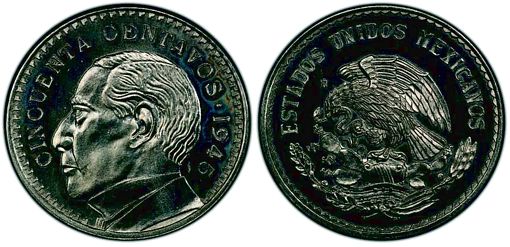
Sample of the unissued coin
In the annual report of the Mexican Treasury, it can be read that on 15 September 1949, President Miguel Alemán sent to the Congress a new initiative to change the Monetary Law, creating new coins. At the bottom of this bill, in the third transitory article, there is a [confusing] mention of the 50 centavos coin (that was never minted for circulation), specifying that no more coins of this type will be produced, despite the nonexistence of that denomination.
Decree of 19 September 1949
Authorized coins: 1c Wheat, 1950-1969 (KM-417), 5c Josefa, 1950 (KM-425), 25c Scales, 1950-1953 (KM-443), 50c Cuauhtémoc, 1950-1951 (KM-449), $1 Morelos, 1950 (KM-457).
Unissued coins: only a 10c Juárez. A copper chiseled sheet is known, engraved by Lorenzo Rafael “El Viejo” (the father).
The coin specifications are a diameter of 23.5 mm, a weight of 5.5 g and an alloy of 75% copper and 25% nickel.
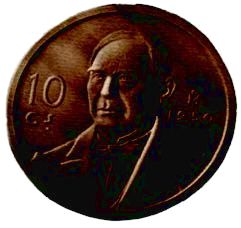 Sample of the unissued coin
Sample of the unissued coin
A second coin for this same decree is a two centavos coin, with a diameter of 19.5 mm, a weight of 3 g, and an alloy of 85% copper and 15% zinc. The design of the obverse was to be a corn with its leaves open, the denomination centavos abbreviated to “Cs”.
Decree of 29 December 1949
Authorized coins: 1c Espiga (KM-417), 5c white Josefa (KM-425), 25c Balance Scale (KM-443), 50c Cuauhtémoc (KM-449), $1 Morelos (KM-457)
Unissued coin: 10c Juárez
Decree of 27 October 1950
Authorized coin; $5 Ferrocarril (KM-460)
Decree of 27 October 1950
Authorized coin: $5 Hidalgo Laurel (KM-467)
Decree of 30 December 1950
Authorized coins: 5c large Josefa (KM-424), 20c Pyramid (KM-439)
Decree of 13 September 1955
Authorized coins: 1c Espiga (KM-417), 5c small Josefa (KM-426), 10c Juárez (KM-433), 20c Pyramid (KM-440), 50c Cuauhtémoc (KM-450), $5 small Hidalgo (KM-469), $10 large Hidalgo (KM-474)
Decree of 26 December 1956
Authorized coins: $1 Juárez (KM-458), $5 Juárez (KM-470), $10 Juárez (KM-475), $1 Tepalcate (KM-459)
Decree of 19 December 1959
Authorized coin: $5 Carranza (KM-471)
Decree of 30 December 1963
Authorized coins: 25c Madero (KM-444), 50c Cuauhtémoc (KM-451)
Decree of 29 December 1966
Authorized coin: $25 Olympics (KM-479)
Decree of 30 December 1969
Authorized coins: 1c Ear of Wheat, 1970-1973 (KM-418), 5c Josefa, 1970-1976 (KM-427), 50c Cuauhtemoc, 1970-1983 (KM-452), $1 Morelos, 1970-1983 (KM-460), $5 Vicente Guerrero, 1971-1978 (KM-472), $25 Juárez, 1972 (KM-480).
Unissued coins: 25c Madero, similar to KM #444 struck in 1964 and 1966, (PL-35 // KMPn# - // B/H# 135), the decree considers a diameter of 22 millimetres, a weight of 5.25 grams, and an alloy of 75% copper and 25% nickel.
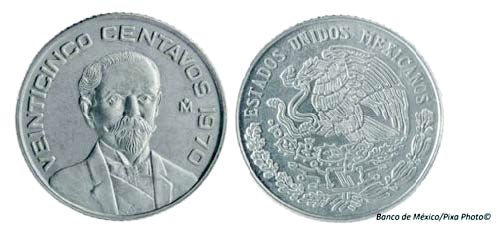 Sample of the unissued coin
Sample of the unissued coin
A second coin approved by the same decree was a 10c with the portrait of Ignacio Allende. The decree mentioned a diameter of 23.5 millimetres, a weight of 5.5 grams and an alloy of 85% copper and 15% zinc, (PL-34 y 34A // KMPn# 206 // B/H# 131). Two patterns are known, the first with the above-mentioned alloy and a second in brass.
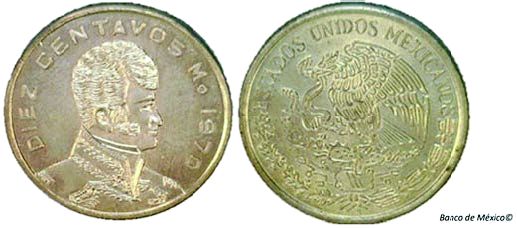 Sample of the unissued coin
Sample of the unissued coin
Decree of 31 December 1973
Authorized coins: 10c Ear of Corn (Mazorca) (KM-434), 20c Madero (KM-442), $10 Hidalgo heptagonal (KM-477)
Decree of 30 December 1976
Authorized coin: $100 Morelos (KM-483)
Decree of 7 January 1980
Authorized coins: 20c Olmec head, 1983-1984 (KM-491), 50c Palenque, 1983 (KM-492)From another perspective all three coins of this decree could be put as examples in this text, inasmuch that all the denominations were approved in 1980, but started circulating in 1983, and patterns of previous years and multiple alloys are known for all the values. See my Las Pruebas de la Moneda Mexicana del Siglo XX pages 191 to 200.
Unissued coins: $1 Eagle Knight, (PL-53 y 53A // KMPn# 219 // B/H# -). The decree stipulates a diameter of 24.5 millimeters, a weight of 5.9 grams and an alloy of 0.920 copper, 0.060 aluminum, 0.020 nickel. It is important to acknowledge that the patterns known so far are of brass and pure aluminum, neither of the alloy approved by the decree. Furthermore, samples of a similar design have been known since 1979, as well as trial-strikes. The engraver commissioned for these coins was Ricardo Luna Vasco.


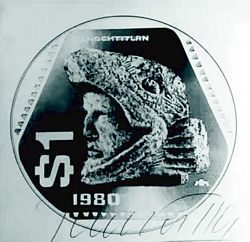
In the National Numismatic Museum in Mexico City the official drawings of all the coins approved are on display, with the signature of President Jose López Portillo.
A different and interesting situation happened with these coins: A subsequent decree nullified the authorization for this $1 coin, ruling that the $1 coin already in circulation (since 1970) (KM #460) would continue to be struck, while confirming the production of the50c and 20c coins.
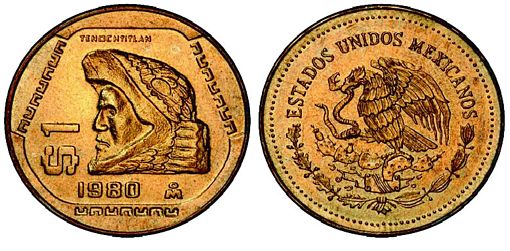
Sample of the unissued coin
Decree of 7 January 1980
Authorized coins: $5 Quetzalcóatl (KM-485), $20 Maya cultura (KM-486)
This decree amends Articles 2 bis and 13 of the 1905 Monetary Law, and provides for coins of precious metals without an engraved nominal value, with legal tender equivalent to the daily price of the metals etc., which would be the precedent for the introduction of gold currency the following year. In addition, it is mentioned that the Banco de México will order the minting of the coin, although the Ministry of Finance will have the final word, being able to veto the decisions.
Decree of 7 January 1981
This decree gives effect to Article 2 bis, as amended, by creating the gold coins of 1, 1/2 and 1/4 ounces.
Decree of 28 December 1981
Authorized coins: 20c Olmeca head (KM-491), 50c Palenque (KM-492), $1 Morelos (KM-496)
Decree of 28 December 1981
Authorized coin: $50 Coyolxauhqui (KM-490)
Decree of 30 December 1983
Authorized coins: $1 Morelos, 1984-1987 (KM-496), $5 Monogram, 1985-1988 (KM-502), $10 Hidalgo, 1985-1990 (KM-512), $20 Guadalupe Victoria, 1985-1990 (KM-508), $50 Juarez, 1984-1992 (KM-495), $100 Carranza, 1984-1992 (KM-493)
Unissued coins: $2 Monogram. The decree mentions a diameter of 15 mm, a weight of 1.5 to 2.0 g and an alloy of multiple metals including chromium, nickel, carbon, silicon, manganese, sulfur, phosphorus, and iron. No minted coins are known, only a drawing by the engraver.
The same situation occurred with a second unissued coin of $200 with the portrait of Emiliano Zapata: the diameter was 29.5 mm, the weight 10.6 to 17 g, and two alloy options, the first of 75% copper and 25% nickel and a second the same as the $2 coin above.
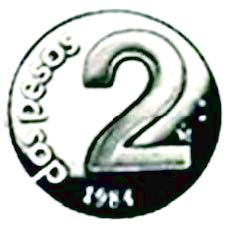
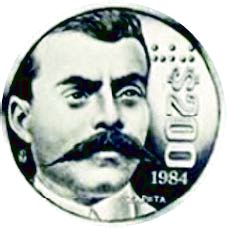
Sample of the unissued coin
Decree of 29 December 1984
Authorized coins: $200 Revolution (KM-510) $200 Independence (KM-509)
Decree of 19 December 1985
Authorized coin: $200 Football World Cup (KM -525)
Decree of 8 January 1986
For the first time, the word "platinum" is added to the Monetary Law, both in Article 2 (c) and in Article 2 bis.
Decree of 19 December 1985
Authorized coins $10 Hidalgo, 1985-1990 (KM-512), $50 Juárez, 1984-1992 (KM-495), $500 Madero, 1986-1992 (KM-529). Of these only the $500 entered circulation.
Unissued coins: $1 Morelos SUD, (PL-63 A 63I // KMPn# 233 a 235 // B/H# 141). The decree mentions a diameter of 15 millimeters, a weight of 2.2 grams, and three different alloys, the first two an assortment of different metals such as chromium, nickel, carbon, silicon, manganese, sulfur, phosphorus, iron, and the third a composition of 0.750 copper and 0.250 nickel. However, ten different alloys are known, dated in 1985 and 1986, despite the decree date.
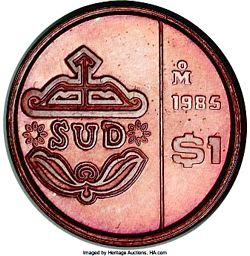
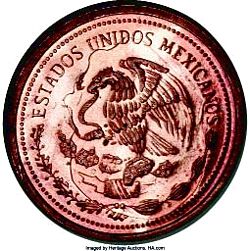
Sample of the unissued coin
Decree of 9 January 1986
This is a second decree of the same date.
Authorized coins: None.
Unissued coins: The Libertad Platinum series, 1oz, with a diameter of 31 mm, a weight of 31 g; ½ oz, diameter of 24.5 mm and weight of 15.55 g; ¼ oz, diameter of 20 mm and weight of 7.76 g. All the coins were to be of an alloy of 0.999 platinum.
The design was to be: for the obverse - in the center the National Coat of Arms in sculptural relief surrounding with the legend " ESTADOS UNIDOS MEXICANOS ". In the frame, seventy-eight denticles (gráfilas escalonadas), and for the reverse - a Victory, with the legend "1 ONZA" [or 1/2 or 1/4] to its right. In the lower right-hand field, the symbol of the Mexican Mint "Mo"; in the lower part of the background, figures of mountains, in the exergue the word "MEXICO", on one side of it the year of minting and on the other side the finess of the coin. Forty denticles in the frame that d the previous engraving does not occupy.
Decree of 5 January 1990
Authorized coins: None.
Unissued coins: The Libertad Platinum series, 1oz, with a diameter of 31 mm, a weight of 34.5 g; ½ oz, diameter of 29 mm and weight of 15.55 g; ¼ oz, diameter of 23 mm and weight of 7.76 g; 1/10 oz, diameter of 16 mm and weight of 3.1 g; 1/20 oz, diameter of 13 mm, weight of 1.5 g. All the coins were to be of an alloy of 0.999 platinum.
These last two decrees contain interesting details. First, the 1990 decree said that the physical characteristics of the platinum coins would be “modified”, assuming that the coins had been struck since 1986, despite this never happening. Second, from our understanding of the text we presume that the design will be the same as the current gold and silver issues, for that reason we can use as an example the 1989 private issue of platinum, - the origin and purpose of this piece is totally different to that mentioned above.
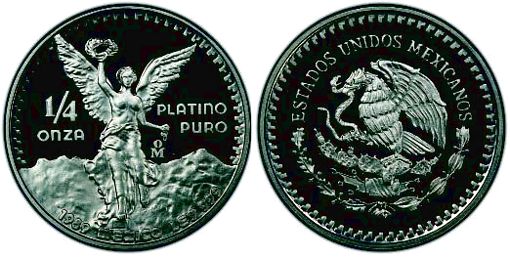
closest sample of the 1986 and 1990 decrees.
Conclusions
The analysis and study of the coining decrees are a very important and useful source of information, that I believe needs a major scrutiny in Mexican numismatics, inasmuch as its content can tell us data of coins from a different approach. Now we know that not all coins approved by the Government end in our hands, or that the final product can be very different from the original project.
